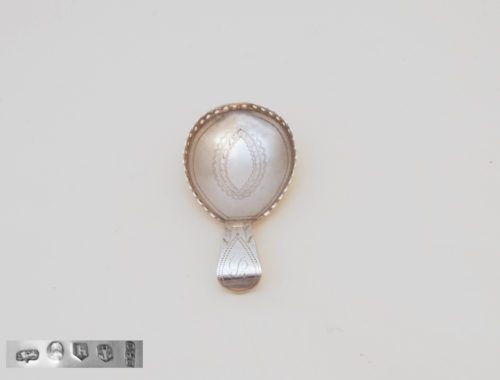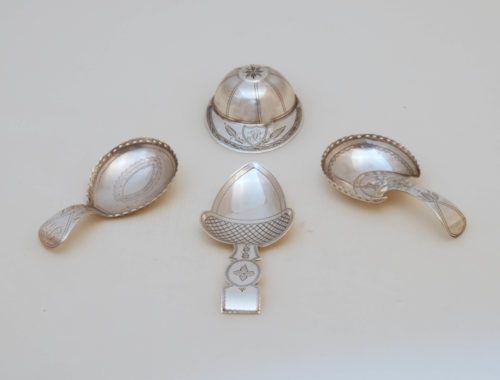Object number # 365
Birmingham 1805-6
Cocks & Bettridge
City’s hallmark/Assay office mark: Anchor in a pointed shield for Birmingham
Maker’s mark: “C&B” for Cocks & Bettridge
Date letter: “h” in a pointed shield for 1805-6
Duty mark: King’s head
Sterling mark: Lion passant
Length: 7 cm (2, 75 in.); weight: c. 5,6 gr. (2 oz.)
Detailed Information
A George III Engraved, Oval Caddy Spoon, Silver
This early nineteenth century, silver, antique caddy spoon is in excellent condition. It has a bright, oval, galleried bowl which is thoroughly engraved with two dot-pricked lines on the borders and in the middle with a more elaborate pattern. The rim of it is high and adorned with an open-cut pattern. The stem is slightly curved and equally thoroughly pricked engraved. On the upper side the initial “B”. The spoon is very well marked on the reverse (handle).
Caddy Spoon
Caddy spoons appear in the English silver since the mid-eighteenth century. They represent a new item within the different categories of silver flatware, due to the change of forms (particularly of the lid) of the tea caddies.
Caddy spoons like other flatware were often personalized through the initial of the owner, in order to be able to easily find the object in case of theft but also to show off the wealth.
Caddy spoons were always required to be hallmarked.
Birmingham Silver
Birmingham was a rapidly expanding commercial center at the beginning of the eighteenth century. Cloth and leather trading became during this period less important and were replaced by metalworking skill. Above all, the production of toys, buckles and guns was very profitable for the city; Birmingham got even the nickname ‘the toy shop of Europe’. Leading toy maker in the town around the mid-eighteenth century was John Taylor. However, metal toy trade was in the decline by 1850.
In the domain of silvermaking in Birmingham, Matthew Boulton dominated there during 1760’s-1790’s. Among other small objects of high quality made in silver (e.g. toothpick boxes) belonged also the tea caddy spoons.
Makers
Cocks & Bettridge had they marked registered in 1796 and 1813. There are some fine examples of their work – and especially caddy spoons – preserved in private and public collections, like the National Gallery of Victoria, Melbourne and the Victoria & Albert Museum, London.
Literatur
Jones, Kenneth Crisp (Hrsg.), The Silversmiths of Birmingham and their Marks 1750-1980, N.A.G. Press Ltd.: London, 1981.
Norie, John, Caddy spoons: An illustrated guide, London: Murray, 1988.




